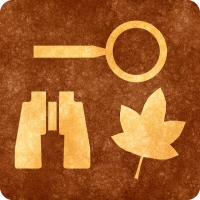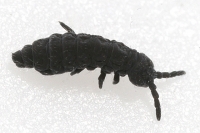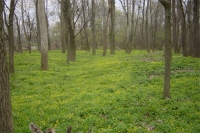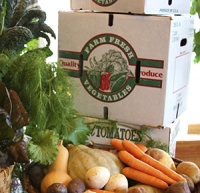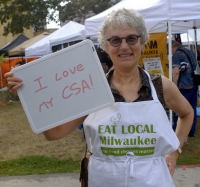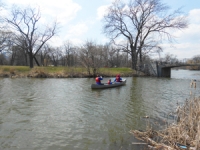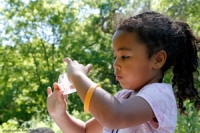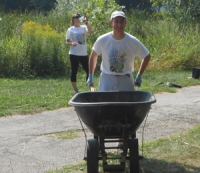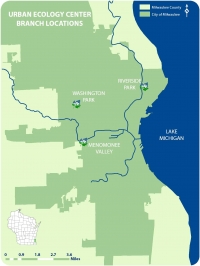
Milwaukee Urban Ecology Blog
I'm very excited to introduce a new series of classes for adults and teens at the Center's Riverside Park branch – The Naturalist Skills Series! These classes are designed to guide observant and inquisitive folks in deepening their understanding of ecological concepts, especially those that are prominent here in Riverside Park. Each month from April through September this learning community will engage in discussions, activities, and observations of a different ecological topic.
Having grown up in Florida, there are some things in the Midwest that are just hard for me to fathom, like the immensity and complexity of Lake Michigan or brutal winters that last from November to April. Another fantastical oddity is a little creature known as the snow flea. When I moved to Wisconsin, I told some friends about bioluminescent critters back home that glow in the dark waters of the Gulf during certain times of the year. They didn't believe me, which is exactly how I felt the first time I heard about snow fleas. I pictured giant fleas hopping heavily on the snow, biting people's ankles as they walked through the woods. I imagined dogs scratching madly as the…
The story of lesser celandine (also known as fig buttercup or pilewort) is the classic story of an invasive species. Native to Europe, northern Africa, western Asia, and Siberia, it was brought to the United States as an ornamental plant. While here, this species found that it had a huge competitive advantage and it took over. In Cleveland, Ohio, lesser celandine was planted in flower beds of (just) two residences in the 1970s. It escaped the confines of those two yards, and less than 40 years later, it had taken over nearly 300 acres of parkland along the Rocky River, with 183 of those acres having lesser celandine cover of more than 50% (that means that lesser celandine covered more…
It was another sunny day in the Menomonee Valley. Delma placed the stethoscope against a gnarly tree branch in Three Bridges Park. Her eyes grew wide and she shouted “I can hear it! The tree has a pulse!” Several minutes, and several tree pulses later, Delma approached me and said, “My grandfather in Mexico used to place his ear to the ground and say he could hear the heartbeat of the earth. Is it true that the earth has a heartbeat? Now that I’ve heard the pulses of the trees I think he is right.” It was one of the most profound and beautiful statements I have ever heard, and it came from a seventh grader.
Connecting people with both their community and their environment is at the heart of what we do. One of the ways we accomplish this is through sustainable food programs like these!
Sometimes changing one small thing can have a huge impact. Curiosity about where her food came from and who was growing it led Anne Steinberg from a passive consumer to a food activist. After participating in a course on sustainable living at the Urban Ecology Center (UEC) about nine years ago, Steinberg decided to try to change just one thing in her life to be more sustainable. She started buying fair trade coffee. Since it was easy enough to change what she was drinking, she decided to change what she was eating, so she became a member of a Community Supported Agriculture (CSA) farm. Having a connection to where and how her food was grown opened her eyes to a…
When I was first hired as an Environmental Educator seven years ago the Washington Park branch was just getting started. I had spent the last four years teaching in a variety of environmental education centers where my outdoor classroom had been a forest. My new outdoor classroom was not a forest but a city park that had a lagoon with a very distinct “stinky end,” some nicely spaced trees and grass. All I could see were the challenges in not having decomposing logs to roll over, undergrowth to play camouflage or a gully of rocks; in short, all the things I was used to having when teaching a class.
Reflecting on all my experiences, I’ve really come to appreciate the pure joy and curiosity preschool-aged children readily exhibit in response to outdoor experiences. I can always count on pockets full of leaves, rocks, sticks and other treasures that kids bring to show me with exclamations of delight! One of my favorite things to do with preschoolers is to flip over these large, black pads that we have in Riverside Park to reveal the invertebrate life hidden beneath. The kids help me point out scurrying centipedes, hustling isopods and wiggling worms.
For 44 years Earth Day has been celebrated around the world on April 22nd as a day to protect, steward and learn about the earth. It’s one of our favorite holidays at the Urban Ecology Center, but we always have too much earth-celebrating enthusiasm for one day. It has caused a bit of a dilemma for us — do we spend the day educating others about our fascinating planet or plan a day of service so you can dig into the dirt? Do we create programs about water or take you out in a canoe to experience it? We want to do it all and one 24-hour day is just not enough. So, we’re declaring April to be Earth Month…
A recent NPR segment on All Things Considered reported some sad news - but brought the acronym “GIS” to light. The father of GIS (geographic information systems), Roger Tomlinson, passed away in early February. He was the first person to devise a computer software to overlay different types of map layers on top of one another, thereby efficiently revealing physical and biological patterns in a landscape or area and streamlining analyses of these patterns. Using current GIS software, the Urban Ecology Center has been able to map a variety of data about our branches and parks.
Copyright © 2023 The Urban Ecology Center

